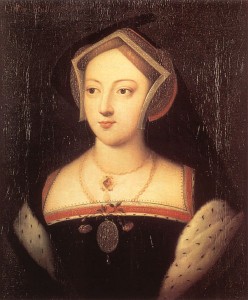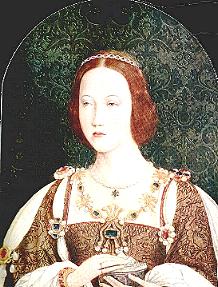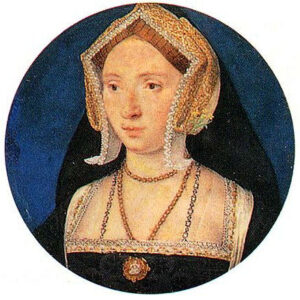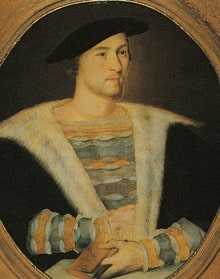
As part of my series on the Boleyn Family, I’d like to take a look at the life of Mary Boleyn, the other Boleyn girl. I want to peel back the myths and stereotypes regarding this woman and find the real Mary Boleyn, but this is a very difficult task as there is little primary source material pertaining to Mary, she was, afterall, just a woman (insignificant in Tudor times) and although she was once the King’s mistress, Mary Boleyn was not a person of importance.
Alison Weir is presently working on “Mary Boleyn: The Great and Infamous wh*re” which is a reappraisal of Mary Boleyn and which will challenge the misconceptions that film, TV and fiction have promoted. It’s not due out until late 2011, but I’m looking forward to reading it and getting an insight into the real Mary. But, for now, you’ll just have to put up with my research which is based on primary sources and the work of historians and authors like Josephine Wilkinson and Kelly Hart.
Background
It is thought that Mary Boleyn was born at Blickling Hall, near Aylsham in Norfolk, the Boleyn family home before they moved to Hever Castle in Kent. Her parents were Thomas Boleyn and Elizabeth Boleyn (née Howard). Mary’s date of birth is not known, although the majority of historians think that she was older than her sister Anne, and was born around 1499/1500. This theory is based on a letter from George Carey, 2nd Baron Hunsdon and Mary Boleyn’s grandson, to Lord Burghley in 1597, in which he asks for advice regarding petitioning Elizabeth I about claiming the earldom of Ormonde. This earldom had once been held by his great-grandfather, Thomas Boleyn, and Hunsdon’s claim to it was based on the belief that the title “should have passed to his father and then on to himself by virtue of their descent from Sir Thomas Boleyn’s eldest daughter, Mary.” Baron Hunsdon surely would have known who was the eldest of the Boleyn sisters and, as Josephine Wilkinson1 explains, if Baron Hunsdon had been mistaken in thinking that his grandmother was the eldest of the Boleyn girls then Elizabeth I, daughter of Anne Boleyn, would have corrected him and claimed the title herself. We can therefore conclude that Mary was Thomas Boleyn’s eldest daughter.
Like Thomas More, Thomas Boleyn believed in giving his daughters a good education. The norm for the times was for girls of their status to learn basic reading and writing, along with music, sewing and embroidery, but the Boleyn girls received a much higher level of education. In 1513, Anne Boleyn was sent to the court of her father’s good friend, Margaret of Austria, to complete her education and although some may argue that this proves that Anne was the eldest daughter, there could be many reasons for Thomas Boleyn’s choice: Anne showed more promise and was more intelligent? Thomas already had plans for Mary? Mary had already mastered French and Thomas thought Anne would benefit more? Mary’s education was further advanced? We just don’t know. However, Mary did not lose out on the experience of going abroad. In 1514 she found herself travelling to France.
France

In 1514, Mary Boleyn was chosen to accompany Princess Mary Tudor, Henry VIII’s sister, to France as a maid-of-honour. Henry VIII had arranged for his sister to marry the ageing King Louis XII of France and Sir Thomas Boleyn, a diplomat and royal favourite, had managed to secure a position for his daughter in Mary’s party.
After a stormy channel crossing, the royal party arrived in France and travelled to Abbeville, where the wedding took place on the 9th October. Shortly after the wedding, Louis XII dismissed the majority of his wife’s ladies but Mary Boleyn was one of the few allowed to stay in France and serve the new French Queen. Just a few months later, in January 1515, the French king died and, after marrying Charles Brandon, the Duke of Suffolk, for love and without her brother’s permission in March 1515, Mary Tudor sailed back to England. But what happened to Mary Boleyn?
It is not clear whether Mary Boleyn returned to England with her royal mistress in 1515 or whether she stayed on in France. Eric Ives is of the opinion that Anne Boleyn, who had travelled from the Low Countries to France for Mary Tudor’s wedding in 1514, stayed on in France as a maid to Queen Claude, wife of Francis I, the new French king, but that Mary Boleyn probably returned to England. Josephine Wilkinson agrees that there is no evidence to support the idea that Mary stayed on in France as an attendant to Queen Claude along with her sister. However, Mary, it seems, had already made the most of her time in France. Josephine Wilkinson writes:-
“As Mary followed her mistress to each of these exciting places, her beauty ensured that she would never be short of suitors sighing after her. It was a heady time which Mary, free of her father’s guiding influence for the first time, was determined to enjoy to the full.”2
One man who appreciated Mary’s beauty was Francis I, who later said that he had known Mary Boleyn in France “per una grandissima ribalda et infame sopre tutte”3 (“for a great prostitute and infamous above all others”). It is said that he also nicknamed her his “English Mare” and boasted about the amount of times that he had ridden her. Of course, this could be just macho boasting, but it is thought that Mary was his mistress for a time before being passed on to royal favourites.
Appearance

Kelly Hart, in “The Mistresses of Henry VIII”, asks “So what was it that made Henry spend approximately four years of his life with Mary Boleyn?”4 and goes on to say that the one surviving portrait of Mary “shows a very appealing woman, with full lips and big brown eyes. She looks attractive even in the popular gable hood, which covered all the woman’s hair, and she appears to have been prettier than her sister.”5 Hart also points out that Mary managed to attract the King of France, various courtiers and the King of England so she must have been attractive.
Josephine Wilkinson writes of how traditionally Mary is seen as prettiest Boleyn sister but “even she, however, did not conform to the Tudor ideal of feminine beauty, which preferred pale skin, blue eyes and blonde hair”6. From her portrait, Wilkinson describes Mary as being plump and having a cream complexion, brown eyes and eyebrows which hint at auburn or chestnut brown hair, but we don’t actually know whether the portrait is actually of Mary Boleyn. Josepine Wilkinson writes of its “doubtful authenticity” and Alison Weir is not convinced that it’s her. However, Josephine Wilkinson suggests that Lucas Hornebolt (Horenbout) may have painted a miniature of Mary around the same time as he painted one of William Carey. Although it is believed that the miniature shown here is of Anne Boleyn or Jane Seymour, the age of the sitter in the mid 1520s matches Mary’s age and Roland Hui7 points out that the badge worn could be the Ormonde falcon. Could this miniature be Mary Boleyn? The wikipedia page on William Carey states that it was Carey who introduced Horenbout into England in the 1520s so perhaps he painted Mary as a favour to Carey?
Character
Kelly Hart writes that “the impression we gain from the scant sources on her is of a kind, loving woman who followed her heart”8, David Starkey describes her as “a placid, unremarkable girl”9 and Antonia Fraser remarked on her “giddy”10 disposition. Again, this is all just supposition, but, as Wilkinson points out, Mary couldn’t have been too giddy or silly because “it is hard to imagine a man of Henry’s intellect being attracted to a stupid woman, much less keeping her as his mistress for any length of time”11, unless, of course, he only valued intellect in a wife. I can imagine Mary as a fun-loving girl who loved the thrill of romance.
In 1534, Mary was a strong enough character to secretly marry for love and perhaps she learned from her former mistress, Mary Tudor, that it was possible to marry for love, as she had done with Charles Brandon. More about Mary Boleyn’s second marriage another day.
Marriage

Mary Boleyn had definitely returned to England by the 4th February 1520 because on that day she married William Carey, a Gentleman of the Privy Chamber and a royal favourite. The King himself attended the wedding, although it is not known whether he had any hand in arranging the marriage.
William Carey was about the same age as Mary and was the son of Sir Thomas Carey and his wife Margaret (née Spencer). His grandfather, Sir William Carey of c*ckingham, Devon, had fought on the Lancastrian side in the Wars of the Roses and was beheaded in the aftermath of the 1471 Battle of Tewkesbury. Josephine Wilkinson writes that the young William Carey was a distant cousin of Henry VIII and that he had joined the king’s household by 1519. His love of sport and art seem to have endeared him to the King, although many of his titles and royal grants may have been a reward for the use of his wife, as Mary Boleyn once again became a royal mistress.
In 1520, William Carey accompanied Henry VIII to the Field of Cloth of Gold and it seems that Mary Boleyn accompanied her husband to this event, being recorded in the listings as “Mastres Carie”. It is likely that she would have been reunited with her sister, Anne, who would have accompanied her mistress, Queen Claude, to the event.
The Royal Mistress
It is unclear when exactly Mary Boleyn became Henry VIII’s mistress. On her return to England Mary became a maid-of-honour to Henry VIII’s wife, Catherine of Aragon, but we just don’t know when she caught Henry’s eye.
The King’s previous mistress, Elizabeth Blount (Bessie Blount) had given birth to the King’s illegitimate son, Henry Fitzroy, in June 1519 and had ceased being the King’s mistress during her pregnancy. Perhaps Mary had caught the King’s eye during the summer of 1519 or perhaps it was 1522, the year that Henry arranged a marriage for Bessie – we just don’t know. However, on the 2nd March 1522, the Shrovetide joust had the theme of unrequited love and Henry VIII rode out on a horse decorated with a wounded heart and wearing the motto “elle mon coeur a navera”, meaning “she has wounded my heart”. Josephine Wilkinson writes that Henry was referring to his new love, his mistress Mary Boleyn and Kelly Hart writes of how it was in 1522 that William Carey began receiving royal grants. In February 1522, William Carey was made the keeper of the manor and estate of New Hall (the Palace of Beaulieu) and also keeper of the King’s wardrobe there. He was also given various other grants and titles, including being made bailiff of New Hall, Boreham, Walkeforde Hall and Powers. Such grants and titles continued being showered on Carey until May 1526, shortly after the birth of the Carey’s second child, Henry Carey, and we can conclude from this that Mary’s affair with the King lasted from 1522 until she became pregnant with her second child in 1525.
Children
See Mary Boleyn Part Two – The King’s Children which will be published tomorrow.
Coming Soon
- Mary Boleyn Part Two – The King’s Children?
- Mary Boleyn Part Three – 1526 – 1543
Notes and Sources
- Mary Boleyn: The True Story of Henry VIII’s Favourite Mistress, Josephine Wilkinson, p11 – 12
- Ibid., p30
- Ibid., p37
- The Mistresses of Henry VIII, Kelly Hart, p58
- Ibid.
- Wilkinson, p64
- A Reassessment of Queen Anne Boleyn’s Portraiture, Roland Hui
- Hart, p58
- Six Wives: The Queens of Henry VIII, David Starkey, p258, quoted in Wilkinson
- The Wives of Henry VIII, Antonia Fraser, p120 quoted in Wilkinson
- Wilkinson, p64